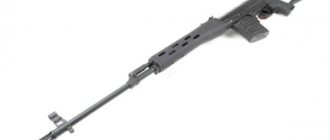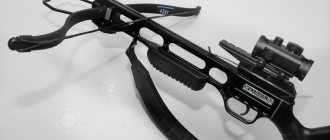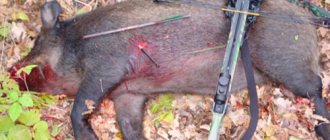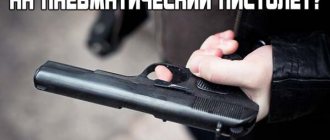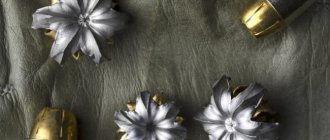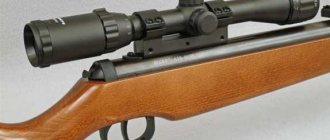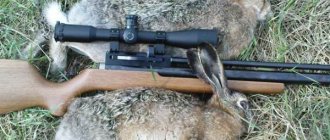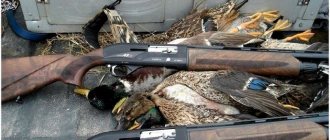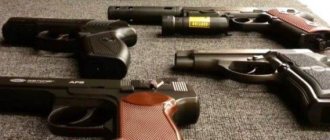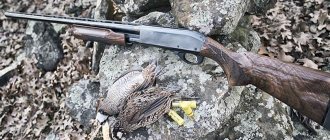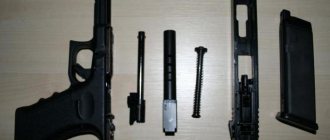Air guns have many advantages over firearms. Air rifle hunting is great for beginners. Most use smooth-bore or rifled weapons. However, the cost of a shot from an air rifle is much cheaper and the rifle itself is much quieter. Professional and powerful air guns allow you to hunt large animals such as wild boar, elk and even bear. High-end rifles allow bullets to develop high speed, which is very convenient when shooting at fast-moving targets. However, this type of weapon is not universal. It can only be used for certain types of hunting.
Night boar hunting
The wild boar is a nocturnal animal; in the dark it goes to feed and can move almost 5 km from its resting place.
In search of food, wild boars leave the dense thickets where they usually live and go out into clearings and clearings, even approaching residential areas. Thanks to its keen sense of smell, a wild boar can smell a hunter at a distance of 500 meters if the wind blows from the direction of the person. Wild pigs also have developed hearing and react to the slightest rustle. The weak point of these animals can be called vision, so the hunter’s task is to disguise himself as best as possible.
When hunting wild boar, different methods are used: hunting from a tower, from ambush, or hunting from the approach. With any of these methods, a night sight for your carbine will be necessary for hunting.
Most often, hunters make ambushes near animal feeding areas, on trails or near reservoirs where animals drink. The hunter lies in ambush a couple of hours before dark and waits for the wild boars to appear. You should shoot at the animal only after it starts eating (or drinking), aiming between the shoulder blades.
The safest way to hunt wild boars is from a tower. Such structures are erected 30-70 meters from special feeding areas, after making sure that wild boars regularly visit them.
Well, daredevils who crave thrills hunt wild boar with approach. In this case, the hunter must approach the animal at a distance of at least 80 m.
Important! For night hunting of wild boar, rifled carbines and rifles with the minimum power .308 Win cartridge are more suitable. Among rifled weapons, carbines from the German company Blaser are popular. The Russian-made Bear, Los and Tiger carbines and the semi-automatic Vepr chambered for 7.62×51 with a bullet weighing 9.3 g are also useful here.
Destroying myths
Beginning shooters also select bullets for pneumatics before purchasing a rifle. For game hunting, you can find ammunition on the market not only from different manufacturers and with all kinds of weights - the bullets also differ in caliber. It is generally accepted that the larger the caliber, the greater the destructive power, but this is not entirely true. In fact, everything depends on the power of the rifle - whether it can accelerate a heavy bullet to a certain speed. But if you compare rifles with the same bullet speed, but with different calibers, the clear winner in terms of lethality will be the larger diameter and weight of the bullet.
There are several types of calibers on the Russian market: 4.5 mm, 5.5 mm, 6.35 mm, 7.62 mm and 9 mm. The first two are quite popular in hunting and are used by almost all gunsmiths. But “heavy artillery” is quite rare, because weapons with a large caliber, regardless of power, require a license.
Night bear hunt
Most often, bears are hunted at night alone, arranging an ambush in an oat field. In early autumn, oats are the main type of food for bears living in central Russia, and in the field it is easy to find paths trodden by animals. The ambush is made in advance, in a place that does not intersect with the bear’s route, using some natural shelter like a haystack.
If the field is surrounded by trees, instead of hiding, you can make a storage shed on one of the trees, at a height of 3-5 meters from the ground. The hunter hides in a hiding place or storehouse before sunset and waits for the bear to appear. For hunting, a rifled gun with a night vision scope is used. If it was not possible to kill the bear right away, and he left wounded, it is dangerous to chase him in the dark - it is better to wait until morning and set the dogs on his trail.
Description of the boar
North Africa is considered the birthplace of the wild boar. Gradually, wild pigs expanded their range, occupying almost all territories.
The exception is the Arctic regions. Speaking of Russia, you can meet wild boars everywhere. The places where herds are most concentrated are:
- South of Western and Eastern Siberia.
- Foothills of the Sayan Mountains and Altai Territory.
Herds of wild pigs populated forest areas and steppes, ravines, where the supply of water is unlimited.
They prefer swampy areas. Areas with tall grass, reeds and bushes.
Genus wild pig: boar or wild boar are artiodactyls.
The food is mixed, the type of which depends on the region of residence. It will not be difficult for animals to change it during migration and quickly adapt to new conditions.
Most often, you can find the cleaver in damp areas of the forest and lowlands. The animal often appears in wetlands and near human habitats.
Boars live in families. They often form numerous herds. The leader of the herd is the eldest female. Males have 3-5 females for communication. The rut begins in late autumn. Ends in mid-winter.
Piglets are born in the spring. The female is capable of producing up to 12 piglets.
Wild boar herds go out to fatten at dusk. After leaving the feeding area during the day, they spend time lying down and taking mud baths.
There is nothing random in nature. Pigs simply need to wallow in the mud. Thus, they maintain temperature balance in the body.
Animals have highly developed hearing. This compensates for poor vision. The animals are maneuverable and easily pick up speed.
Boars are aggressive and can go on a decisive offensive to protect the interests of the herd and cubs, trying to injure the enemy with their tusks.
- Boar prints.
The footprint of a wild boar on the ground differs from the traces of other ungulates. We're talking about the relationship between stride length and footprint size. The boar's stride is short. A boar's footprint is twice as large as that of a moose calf. The size of the footprint of a pig's front foot, its length, is 100-150 mm.
A slow-moving adult cleaver leaves a trail of 400-500 mm. The boar has short legs. Therefore, he waddles, leaving traces in the form of a Christmas tree.
When trotting, the footprint increases to 900 mm. It's practically a straight line. If the animal runs at a gait, the trail of the cleaver can reach 1.5-2 meters. Moving in winter through snow 300-400 millimeters thick, wild boars walk one after another: in single file, leaving a continuous furrow behind them.
Night hunting for foxes and hares
Hunting for foxes and hares is usually carried out in the winter season, when their fur becomes especially fluffy. For night hunting of these animals, ambush is used near the bait.
The carcass of any large domestic animal is used as bait for foxes; you can also get by with the entrails of a cow, goat or pig. Complementary food is hidden in a small hole, lightly sprinkled with earth. Having made sure from the tracks in the snow that the foxes have discovered the bait, not far from it they build a hiding place (hut, dugout) or storage shed in a tree. Hiding there before dark, the hunter waits for the foxes, having previously installed a night optical sight on his gun.
They hunt hares at night in a similar way, only they use tree branches (aspen, birch, etc.) and cereal plants or vegetables as bait, after watering them with a weak saline solution.
Important! For shooting at hares, smooth-bore shotguns with shot No. 1, 2 or 3 are used. The best choice would be a 12-gauge double-barreled shotgun with an interchangeable pair of barrels or muzzle attachments. Experienced hunters prefer the Saiga smoothbore carbine, having previously installed a night attachment on the sight.
Night hunting for deer, elk, roe deer
Important! To hunt large animals, large-caliber weapons are used, for example, hunting carbines “Moose” and “Bear”. When hunting from ambush, it is best to have both rifled and smooth-bore weapons with you.
The most popular methods of hunting ungulates at night are shooting from towers or from ambush. Shelters are built 50-80 meters from the feeding area; night vision devices are used to observe and shoot at animals. Sometimes ungulates are hunted at night in jeeps, blinding the animals with powerful headlights, but this method is considered poaching.
Using night vision scopes when hunting at night
When hunting at night, you can’t do without night vision devices – at least to see the target and know where to shoot.
There are 3 generations of night vision scopes, each of which has its own advantages and disadvantages.
- Night sights of the 1st generation do not have the best characteristics in terms of recognition range: the image obtained in the dark is not clear enough at the edges, there may be dark dots on the image intensifier, which is acceptable when released from the factory. Hunting with such a sight is possible only in conditions when there is at least a quarter of the moon in the sky; on a completely moonless night, additional IR illumination will be needed.
Depending on the degree of sky illumination, the first generation sights allow you to see a target at a distance of 50 - 150 meters. Previously, these devices used a glass tube of an image intensifier; they were not recommended for installation on high-caliber smoothbore shotguns due to strong recoil that could damage the scope (for more details, see the article “Night vision sights for 12 gauge”). Now image intensifiers are installed in a ceramic housing, which makes it possible to use certain models with a powerful magnum cartridge. The main advantage of the 1 and 1+ generation of night sights is their relatively low price, so they are well suited for novice hunters.
- Night vision scopes of the 2nd generation, as well as generation 2+, do not have the shortcomings of their predecessors: they provide a very clear picture even on moonless nights. When the sky is cloudy, it is possible to see the animal through the scope at a distance of 145 meters, and under a full moon – at a distance of 630 meters. Generation 2+ sights are not afraid of recoil, so they can be installed on smooth-bore weapons of any caliber. If you have such a sight, it is almost impossible not to hit the animal: according to statistics, the frequency of hits on a target in open areas is 80-90%.
- 3rd generation night sights have the most powerful optics, but they are also the most expensive. With such a sight, the hunter can see everything that happens in the night forest down to the smallest detail, even on the darkest night. On a full moon, these devices will allow you to see the animal at a distance of up to 830 meters, and under cloudy skies - at a distance of about 200 meters.
- Digital night vision sights went on sale in 2010. This equipment is not much more expensive than 1st generation sights, but its characteristics are much better. Digital sights can be installed on guns of any caliber; you can hunt with them not only at night, but also in daylight; just one shot is enough for zeroing. Such devices have many additional functions, such as video recording and GPS navigator. Digital night sights allow you to see in the dark at a distance of up to 200 meters. Read more about choosing digital sights in this article.
| PN-2M | Phantom 3x50 Pulsar | PN23-3 "Saracen" | Digisight LRF N970 |
. . [+ Autumn hunting is here]
We went hunting here in one of the regions in the south of Russia, and got a wild boar with a Career PCP rifle 9mm (pneumatic hunting weapon). Despite the bitter cold, the hunt took place.
There had been plans for a long time to go hunting to lands somewhere further south from the center; besides, I wanted to see new animals that are not found in the north, for example, roe deer. Moreover, to the south, wild boars and roe deer live in the same lands, together. However, while my friend and I were discussing and planning, the roe deer hunting season ended (in December), and when my friend was able to go, the hunt remained open only for medium-sized gilt boars. And then the frost hit -20* for a long time. But, we decided not to give up and go! See new places. Prepare in advance for the difficulties of frost. And I was also interested in testing the PCP rifle in harsh frosty conditions. But, I prepared her for this. I carried out preventative maintenance - replaced old o-rings and grease (after 4 years of operation), cleaned the valves, tightened the screws. At the same time, I removed the narrowing of the bypass that was there, thereby increasing the power by 15%. Just compensated for the drop in power in the cold. I sighted the weapon with a Bushnell 3-12x44 FFP illuminated scope for hunting at dusk. I planned to use my pressed bullets, the most expansive and powerful 8 g weight, with a cavity in the front, with a ballistically optimal round “back”. I made them in advance, selected the optimal shape and weight, and shot them at the shooting range for accuracy. Their large expansiveness and weight, and their average accuracy, were just suitable for hunting from a storage shed at 25-60 meters.
Hunting. The further south you went along the route, the fewer forests there were, and the fields became wider. However, 30 km before the hunting grounds, the fields gave way to copses, and then there was a real pine-birch forest, with spruce islands. At the entrance to the hunting grounds, we immediately noticed a large number of tracks of various animals in the snow. This made me happy.
At the hunting base, we immediately met the head of the hunting farm, he said that hunting is allowed only for medium-sized gilts from the storage shed, asked what weapons we had, and if we had any hunting experience. I immediately said that I had a 9mm hunting pneumatic gun, with which I took gilts and beavers in the Leningrad Region, showed them photos, a rifle and bullets. He looked and allowed us to shoot small pigs, reminding us that there would be a fine for a wounded animal that was not picked. “Take a shot very responsibly!” he said. He wished him a successful hunt and left. The huntsman was supposed to take us to the warehouses.
Before the hunt, I took the rifle outside to cool, and shot the cooled rifle right in the cold in the forest, at 50 meters, to be sure of a hit. The pressure that had dropped due to the frost was pumped up in the cold. So that you no longer fall from the cold in the forest. This gave some confidence in the stability of the point of impact. I didn’t want to miss the kill zone. And the frost outside was -16:-20*C! In the evening we went to the storage sheds in the forest - these covered “cubes” on poles, with a door and a window for shooting. About 40 meters from the storage shed, bait (corn, potatoes, etc.) was poured. A comrade with a smooth-bore firearm went to the first storehouse, and I was taken to a further one, deep into the forest.
At the storage sheds we sat alone, without a huntsman. They gave us walkie-talkies so that when we were completely frozen, we would report and pick us up. It’s interesting at the storage shed - you can see far away in the forest, I sit and look at the snow near the bait, through which plump mice run and eat seeds. The frost grew stronger, especially when the sun set and it began to get dark. I took a thermometer with me for the street, it was interesting how many degrees it was. It was minus 18*. First, the doe came out to feed, ate, and left. I even managed to take a picture of her while it was still light.
Then at dusk the roe deer began to walk, sometimes one at a time, sometimes two at a time, sometimes a male, sometimes a female; from afar from the forest you could hear the crunch of their hooves on the snow. They approached carefully, ate and left... And silence... There were no boars. Only far in the forest I saw some kind of carcass, either an elk, or a wild boar... But he did not come closer, and disappeared. It got completely dark, the frost pressed the thermometer needle to -20*!! I wait another hour, but there are no wild boars. The full moon came out, but they never came out. I called the huntsman, it’s no longer possible to freeze... Dima was also unsuccessful - besides the roe deer, only two large boars came out (they cannot be shot), and there were no gilts.
At the base they discussed why my wild boars didn’t come out. Dima advised me to do something to remove the smell of a person from the storage shed.
*He suggested an original method - take a “chicken soup cube”, and smear it on the front door of the storehouse, around the window, and sprinkle it slightly down on the snow. The smell of chicken will take away the human smell. I thought he was joking, but he seriously said that he did it himself, and the pigs came to him. Well, I took two cubes of chicken from him, I’ll try it, I think... doubting it.
The next evening we again sit in the storage sheds, but in different places. I was successfully taken further into the forest, to a distant storage shed, to a dense forest with a dense spruce forest to the left of the storage shed, and in front of it there were sparse birch trees and bait sprinkled (see photo view from the storage shed). The huntsman advised me to get out 300 meters from the hunting site in advance, and approach there quietly on foot, so as not to frighten away the wild boars, possibly living in the spruce forest, with the noise of the car and the smell...
I approached the storehouse, climbed in, smeared the storehouse window and the entrance with a “chicken cube”, I observed... First, two roe deer, a female and a male, came out of the forest again, ate and slowly moved away. The sun had set, dense twilight had deepened, and the frost intensified. It was -17*!... It was getting dark. I turned on the reticle illumination...
Again two roe deer came and began to eat, but suddenly... on the left in the fir trees something began to puff heavily and smelled of the smell of a pigsty!... The roe deer immediately perked up, and they were blown away as if by the wind! “I became wary, loaded the rifle and froze... There was a crashing sound, and a large boar cautiously crawled out into the clearing on the left, sniffing and looking around... She sniffed and briskly went to feed, and behind her were two more boars and several frisky grown-up large gilts, already shaggy and dark, like adult boars. They all began to spin, run, grunt, and eat bait. I just couldn’t get my sights on the killing zone of the gilt, they were all spinning constantly, and I was torn by emotions!!! ...The pigs were constantly turning their heads, and I decided to shoot at the area under the shoulder blade, diagonally forward, to pierce the lungs and hit the heart. Moreover, a year ago this was already successful; the gilts did not go far. He took aim at the pig and fired, 30 meters away. - Shot! - and all the boars instantly, grunting and stomping, rush to the right, and from behind, rounding the storehouse, go into the fir trees to the left... But I heard that behind the storehouse someone groaned and snorted immediately after the shot, when the stomping of the boars had already died down in the fir trees... I think that’s probably it That’s where the little pig fell... although, of course, I doubted it, suddenly it left... anything can happen. I’m sitting here, my heart is pounding! It even became hot right away, how cold it is there! I waited half an hour, everything was quiet in the fir trees, even the roe deer had already entered the clearing again... It got dark and the moon came out. That's it, I decided to go take a look. He turned on a powerful flashlight, loaded a rifle on his shoulder, and walked along the path where the wild boars had run away. And, here’s the joy - I didn’t even have time to walk 30 meters, I see a carcass lying under a bush, fresh blood on the snow and on a tree, and this is my pig, already ready! Only 30 meters from the storehouse. I couldn’t even believe in success! (Otherwise, I had bad luck hunting all autumn; I couldn’t even get a hold of the game in my sights...). Well, just a photo for memory, of course.
I called the huntsman on the radio, he arrived, we dragged the animal into the car, it turned out to be heavy, 55-65 kilos... We loaded the animal and drove through the forest to another storage facility to pick up a comrade from there. But things didn’t go well for a friend - wild boars with two pigs came out to him, but they were far from the storehouse and inconvenient for shooting a bullet from a smoothbore... But they never came closer, they were scared of someone’s voices in the forest and left - someone from the locals climbed through the forest.
My friend and I took a photo next to my beast:
At the base, we gutted the beast and found my bullet under the skin on the other side of the hit. The 9mm bullet passed diagonally through the entire carcass, from the right to the front and slightly down to the left: it pierced the right rib, passed through both lungs and caught the vessels of the heart, pierced the second rib and stopped just under the skin at the chest. In the lungs, the thickness of the wound channel was about 3-4 cm. An 8g bullet of 9mm caliber opened up to a diameter of 14 mm. Photo: ___
Before leaving, I was given a coupon for “hunting products”, along with a “permit to hunt” for wild boar.
I gave most of the meat to my comrade so that he would also have some spoils, despite the unsuccessful exit of his beast. The morning before leaving, we went to look at the nearest storehouse in the forest, it turned out to be small, and not like the one where I hunted:
_
In such cold weather (-16..-20*) everything worked: the Career PCP rifle worked normally, the night optics (the NB device <Yukon Exelon 3x50>, and the NB attachment on the sight, <Challenger 1x20>) worked normally, only the plastic lens caps are very stiff; and we ourselves also became a little stiff; Well, the brightness of the reticle illumination in the scope has decreased, but this is even good in the twilight. The experiment was a success. In short, you can hunt down to -18*C.. From sitting in the cold for a long time, only my hands and feet froze a little, even in shoe covers and warm gloves. Warm clothes are the most important thing in the cold. . And in the summer season we’ll try to hunt roe deer, if it works out... maybe even from the approach.
P.S. As for animal hunting with large-caliber air rifles (RSR rifles cal. 0.45 and 0.58) - for those interested, a new interesting film has been released about such a deer hunt in the autumn forest from the approach, American. We caught two antlered deer. The shooting is not bad. Link: https://www.youtube.com/user/Ad...u/6/M9tRC8x11Tk
Good luck to all.
P.S. PART-2 / - Addendum - Autumn 2012. /
HUNTING in these hunting grounds in southern Russia continued this fall. We hunted there again. — My hunting buddy Dima and I decided to go again to those lands for the autumn hunt for trophy male roe deer, and, as a last resort, for young pigs, if there are no roe deer... -Here is the story about this autumn hunt here: https:/ /forum.guns.ru/forummessage/135/942472-s26969535.html
Night vision goggles and infrared laser designator
Night vision goggles are attached to a special mask, which is put on the head and leaves your hands free. Unlike a night vision scope for hunting, the goggles do not visually bring the target closer, which allows you to really assess the distance and see what is happening around you without distortion. These glasses are indispensable for hunters who sit in ambush for hours - they allow you to observe the fascinating night life of the forest without attracting attention to yourself. If necessary, the glasses can be periodically moved to the forehead to look around with the naked eye.
An infrared laser target designator is used together with night vision goggles. The device is mounted on an optical sight and, when aimed at an object, creates a small red spot of light, which helps the hunter hit the target accurately. When hunting at night, it is very important to shoot at a certain point, for example, between the shoulder blades of the animal. If you miss slightly, the wounded animal will leave, and chasing it in the dark is quite difficult. In this case, a laser pointer makes the task easier.
Night vision monocular and red dot sight
Another convenient device for night hunting is a night vision monocular. This compact device is something like binoculars, but with one eyepiece, that is, you can look into it with only one eye. Monoculars are distinguished by the degree of lens magnification: it usually ranges from 1 to 5. The advantages of these devices include their light weight and size - the monocular can be held in your hand, placed on a tripod, or mounted on your head using a mask.
Night vision monoculars are used for hunting in combination with collimatron sights that do not have dioptric properties. Such sights, unlike NVG sights, are quite lightweight and can be installed on any type of weapon. Collimator sights can be used for both day and night hunting, in the latter case they are switched to night mode.
When should you attract a roe deer?
The decoy is used exclusively during the main rut, that is, from mid-July to the end of August. The height of the rut falls on July 20 - August 20. The peak is observed in the first half of August. If you missed the summer rut, you can try your hunting luck during the second rut, which runs from late November to mid-December.
However, our country is quite large, so in some regions the deadlines may shift slightly, in particular:
- on the main European territory of Russia, the roe deer rut is observed from mid-July to the end of August;
- in Transbaikalia - from early August to early September;
- in the Caucasus, Crimea, the Urals and the territory of Western Siberia - from late July to early September.
The point of this hunt is to use a decoy (for example, you can take a Hubertus BUTTOLO 290 roe deer decoy) to lure the animal to you. The decoy reproduces the sounds made by the female, or imitates the cry of a wounded animal.
The decoy allows you to realistically imitate calling sounds: the whistle of a female in heat, an explosive whistle, the cry of a frightened calf, etc. An experienced hunter with the help of these sounds can easily lure a male or a pair of animals at once (a male and a female).
Usually females come into the rut first in their second year of life, adult females a little later. During the rutting period, special glands of females secrete special volatile substances with a strong odor, which, intoxicating the males, make them easy prey for the hunter. Males at this time strive to find females.
Females go into rut for about three to five days. At this time, the male is chasing the female, who is in the preliminary heat stage, but she does not allow herself to be covered. After this, the second phase of the rut begins, when the males cover the females. Male roe deer do not form harems, remaining with one female the entire time she is in rut. Often males have to win a female by fighting other rivals.
Considering the entire rutting period to be the right time for hunting with decoys is a big mistake. As a rule, hunting success increases closer to the end of the rut. This is due to the fact that the number of females in the rut by this time is greatly reduced. And males who lack a female are more willing to fall into the hunter’s trap at the sound of a decoy. Therefore, it is better to start hunting with a decoy in the first half of August, it is at this time that the male will be good at going to the decoy, imitating the call of a female in heat. The sexual instinct of males is still very strong at this time. If you use a decoy intensively during this period, your chances of a successful hunt will be greater.
Night hunting with a thermal imaging sight
A thermal imaging sight or monocular has a number of advantages over optical and night vision devices. In particular, they allow you to observe the animal in heavy snow, fog, rain, through foliage, and even identify places of camouflage. However, observation with a thermal imager has its own specifics: the horizon is not visible, the absence of an optical image (only thermal spots), the high cost and relatively low reliability of the device due to its design complexity. Read more about choosing a thermal imaging sight in the article, and here is a comparison with night sights.
Boar hunting with night vision scope
